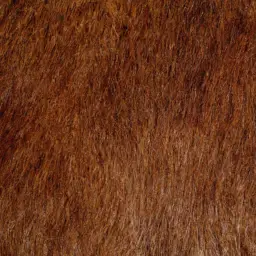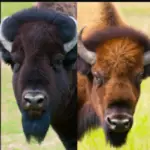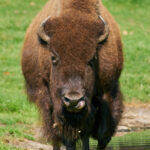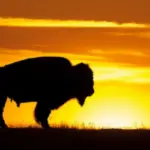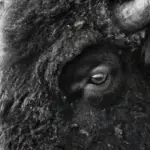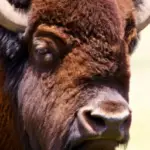Do you ever find yourself wondering about the colors of different animals? If so, look no further than the intriguing product known as “What Color Is Bison.” This product is designed to satisfy your curiosity by providing you with detailed information about the colors of bison. With its easy-to-use interface and comprehensive database, you will be able to explore the various colors and patterns that bison exhibit. Whether you have a passion for nature or simply enjoy learning new facts, “What Color Is Bison” is the perfect tool to expand your knowledge and satisfy your curiosity.
General Coloration of Bison
Bison, also known as American buffalo, exhibit a range of colors in their coats. These variations in coat color are influenced by several factors, including genetic variation, seasonal changes, sex, and age. Understanding the general coloration of bison provides valuable insights into their appearance and behavior.
Variations in coat color
Coat color variations in bison can range from dark brown to light tan, with some individuals even displaying shades of reddish or yellowish tones. This natural diversity in coloration is primarily attributed to genetic factors. The combination of different alleles and genetic markers results in the wide array of coat colors seen in bison populations.
Seasonal changes in color
Bison’s coats undergo seasonal changes, particularly in regions with distinct seasons. During the winter months, their coats tend to become thicker and darker, providing insulation and camouflage against the snowy backdrop. In contrast, during the warmer seasons, bison coats may appear lighter in color, allowing for better heat dissipation and adaptation to their environment.
Differences in sex and age
Sex and age also play a role in the coloration of bison. Male bison, or bulls, often exhibit darker and more prominent coats compared to females, or cows. This disparity in color helps distinguish between the two sexes, aiding in reproductive behaviors and social interactions within the herd. Additionally, young bison, known as calves, typically possess a lighter coat color, gradually transitioning to their adult coloration as they age.
Detailed Description of Bison Color
A closer examination of bison color reveals distinct characteristics and patterns that differentiate adults from young individuals and highlight changes throughout their life cycle.
The color of adult bison
Adult bison generally display a solid and uniform coloration across their body. Their coat color can vary significantly, ranging from deep brown to light tan. This variation arises from genetic factors and may be influenced by environmental conditions, such as availability of specific nutrients or exposure to sunlight.
The color of young bison
Young bison, or calves, exhibit a different coloration than adults. Their coats often have a lighter and more mottled appearance, consisting of varying shades of brown. This lighter coloration provides camouflage and allows them to blend in with their surroundings, offering protection from predators.
Color changes throughout the life of a bison
Throughout their life, bison experience color changes as they transition from calves to fully grown adults. As calves mature, their coat color gradually darkens and becomes more consistent, resembling the typical coloration seen in adult bison. These changes in color outline the developmental stages of bison and contribute to their overall appearance and adaptability.
Comparative Analysis of Bison and Other Bovine Species
When comparing bison to other bovine species, such as cattle and buffalo, notable differences in color patterns can be observed. These differences hold significance in species identification and demonstrate the impact of environmental factors on coloration.
Differences in color patterns
Bison and cattle exhibit unique color patterns that help distinguish them from one another. While bison typically have a solid, uniform coat color, cattle may display a wider range of patterns, including patches of different colors or distinct markings. This distinction allows for easier identification of the two species in the wild or on ranches.
Role of color in species identification
Color plays a crucial role in species identification, particularly in the case of bison, where subtle variations can occur within a single species. By analyzing the color patterns and characteristics specific to bison, researchers and wildlife enthusiasts can accurately differentiate them from other bovine species, contributing to proper species management and conservation efforts.
Impact of environmental factors on coloration
Environmental factors, such as climate and habitat, can influence the coloration of bison and other bovine species. Adapting to different environments often leads to changes in coat color to provide better camouflage or protection from predators. These adaptations showcase the remarkable ability of bison to thrive in various habitats while ensuring their survival and success as a species.
Genetic Basis of Color Variation in Bison
The color variation observed in bison is not solely attributed to environmental factors but also stems from genetic variation within their populations. Understanding the genetic basis of color variation is essential for unraveling the complexity of coat color in bison.
Common genetic causes of color variation
Genetic causes of color variation in bison involve the presence of specific alleles and variation in pigment-producing genes. These genes influence the production and distribution of melanin, the pigment responsible for coat color. Individual bison may inherit different combinations of these genes, resulting in a wide spectrum of coat colors observed in the population.
Uncommon genetic anomalies in coloration
Occasionally, uncommon genetic anomalies can manifest in bison coat coloration, resulting in unique or rare color variations. These anomalies, such as albinism or melanism, arise from genetic mutations that disrupt the normal pigmentation process. While these occurrences are relatively rare in bison populations, they serve as a testament to the genetic diversity and potential for novel colorations within the species.
Research and studies on bison genetics
Researchers and scientists have conducted extensive studies to unravel the genetic basis of color variation in bison. By analyzing DNA samples from different bison populations, researchers can identify specific genetic markers associated with color variation. These studies contribute to our understanding of the genetic mechanisms underlying coat color and aid in broader conservation efforts to preserve genetic diversity in bison populations.
Influence of Color on Bison Behavior
Color plays a fascinating role in shaping the behavior and social dynamics of bison herds. From mating preferences to social hierarchy, understanding the influence of color on bison behavior provides valuable insights into their interactions and reproductive strategies.
Impact of color on bison mating
In bison herds, color can influence mate selection and reproductive success. Male bison with darker and more prominent coats are often preferred by females during the mating season. The intensity and richness of the coat color can serve as a visual cue for female bison, indicating the genetic quality and health of potential mates. This color-based mate selection contributes to the overall fitness and gene pool of bison populations.
Color-based social structure in bison herds
Bison herds exhibit a hierarchical social structure, where individuals with darker coats often hold higher positions within the hierarchy. The darker coloration signifies maturity, dominance, and reproductive success, as these individuals have proven their genetic qualities and ability to navigate the challenges of their environment. Lighter-colored individuals may occupy lower positions in the social hierarchy, with less access to resources and lower reproductive success.
Color perception in bison
While the exact mechanisms of color perception in bison are still being studied, it is believed that they possess color vision to some degree. The ability to perceive and distinguish between different colors aids in mate selection, identification of individuals within the herd, and assessing the general health and condition of conspecifics. Understanding the nuances of bison color perception can further enhance our understanding of their behaviors and interactions.
Impact of Disease and Health on Bison Color
The health and well-being of bison can be reflected in their coat color, making it an essential indicator of disease and overall health status. Various diseases and health issues can influence the coloration of bison, providing valuable diagnostic information for wildlife conservationists and veterinarians.
Diseases affecting bison coat color
Certain diseases can result in changes in the coloration of bison coats. For instance, infections or infestations by external parasites, such as lice or ticks, may lead to hair loss and alterations in the overall appearance of the coat. Additionally, diseases that affect the bison’s immune system or metabolism can impact the pigmentation process, resulting in abnormalities in coat color.
Indications of health issues through changes in color
Changes in coat color can serve as visible indicators of potential health issues in bison. A dull, discolored, or patchy coat may suggest nutritional deficiencies, underlying infections, or systemic diseases. Monitoring and identifying these color changes can help wildlife professionals and veterinarians identify and address health problems in bison populations promptly.
Quality of hide and fur in relation to health
The quality of bison hide and fur is closely related to the overall health and condition of the individual. A healthy bison with a well-nourished coat tends to have strong, lustrous hair and supple skin. Conversely, bison with compromised health, poor nutrition, or underlying medical issues may display lower-quality hides and fur that lack the desired characteristics, impacting their value for commercial use.
Role of Bison Color in Native American Culture
Bison hold significant cultural and spiritual significance for many Native American tribes, with their coloration playing a vital role in various cultural practices, artwork, and beliefs.
Bison color symbolism in native culture
Color symbolism in Native American cultures often assigns specific meanings or associations to various colors, including those observed in bison. For example, the dark brown or black coat color of bison may symbolize strength, resilience, and connection to the earth. Lighter or reddish tones may represent vitality, abundance, or even specific ceremonial purposes. These color associations provide rich layers of meaning within the cultural context of Native American communities.
Use of bison color in traditional art and attire
The coloration of bison has influenced traditional Native American art forms and attire. Natural pigments derived from different parts of bison, such as their hair or hides, have been used to produce dyes for textiles, pottery, and paintings. These colors not only serve as aesthetic elements but also carry cultural significance, preserving and promoting Native American artistic traditions.
Native American beliefs on bison color variation
Native American beliefs often attribute spiritual or symbolic meanings to the color variations observed in bison. These beliefs may vary among tribes or regions but commonly emphasize the unique qualities associated with different coat colors. For instance, a bison with a distinct or unusual coat color might be considered a symbol of individuality, divine favor, or a spiritual messenger. These cultural beliefs enrich the connection between Native American communities and the natural world, promoting a deeper understanding and appreciation of bison color variation.
Use of Bison Fur and Hide in Industry
The fur and hide of bison have been valuable resources for human use throughout history. The color of bison hide plays a significant role in determining its value and application in various industries.
Color’s impact on value of hide
The color of bison hide can influence its market value and desirability for commercial use. Depending on the specific industry requirements and consumer preferences, certain hide colors may fetch higher prices or be considered more valuable for particular product lines. Lighter or more uniform coat colors are often favored in industries where hides are used for luxury goods, upholstery, or fashion.
Changes in color after processing
Processing techniques and treatments can alter the color of bison hides to meet specific industry needs. Tanning, dyeing, and other treatments can modify the natural color of the hide, creating a more uniform appearance or achieving desired shades. These processing methods allow the industry to adapt bison hides to different market demands while still utilizing the inherent qualities of bison as a sustainable resource.
Industries dependent on bison hide color
Several industries heavily rely on the color and quality of bison hide for their products. The fashion and apparel industry often utilizes bison hide for creating premium leather items such as jackets, handbags, and footwear. Additionally, the furniture industry may incorporate bison hides into upholstered pieces, seeking unique colors and textures that complement their design aesthetics. These industries benefit from the versatility and distinctive characteristics that bison hide color provides.
Effect of Climate on Bison’s Color
The natural environment and climate can significantly impact the coloration of bison. Adapting to various climates has shaped the evolution of bison’s coat color and provided them with valuable survival advantages.
Impact of climate on coloration
Different climates impose selective pressures on bison populations, leading to adaptations in coat color. In regions with snowy winters, a darker coat provides better camouflage against the white backdrop, increasing the chances of survival by minimizing the risk of predation. Conversely, in grassland or open savannah habitats, lighter coloration may offer improved heat reflection and camouflage during warmer seasons.
Bison color adaptation to various climates
The coloration of bison represents an evolutionary adaptation to their respective habitats and climates. Over time, natural selection has favored coat color variations that enhance survival and reproductive success. By blending into their surroundings, bison can effectively avoid predators, locate food sources, and regulate body temperature, ensuring their survival in diverse environments.
Global warming and bison color
The ongoing effects of global warming and climate change pose potential challenges for bison populations. As climates shift and habitats undergo transformations, the adaptive value of certain coat colors may change. Rapid environmental changes can disrupt the natural selection pressures that have shaped bison coloration, potentially impacting their camouflage, thermoregulation, or overall survival. Understanding these potential impacts is crucial for the conservation and management of bison populations in a changing world.
Does the Color of a Bison Affect the Sound It Makes?
The color of a bison does not affect the bison sound communication. Bison communicate through various vocalizations and body language, rather than being influenced by their specific coloration. Their deep grunts, snorts, and bellows are used for social interaction and to assert dominance within the herd.
Preservation Efforts and Its Impact on Bison Color
Conservation efforts and the establishment of zoos and wildlife reserves play a pivotal role in maintaining and preserving the diverse coat colors seen in bison populations. These preservation efforts have the potential to impact the future patterns of bison coloration.
Effects of conservation efforts on bison coat color
Conservation efforts aimed at protecting bison populations can indirectly contribute to the preservation of coat color diversity. By safeguarding natural habitats and minimizing human-induced disturbances, conservation initiatives provide a conducive environment for bison to thrive, allowing for the preservation of genetic diversity and the full spectrum of color variations within populations.
Role of zoos and wildlife reserves on color preservation
Zoos and wildlife reserves play an essential role in the preservation of endangered or threatened bison populations. Through controlled breeding programs and genetic management, these institutions can maintain healthy and sustainable populations that reflect the natural coat color diversity observed in the wild. By ensuring the survival and well-being of bison, zoos and reserves contribute to the future preservation of the species’ unique color patterns.
Future predictions on bison color patterns
Given the dynamic nature of bison populations and the ongoing impact of various factors, predicting future bison color patterns can be challenging. However, continued research, monitoring, and conservation efforts offer hope for the preservation of the genetic diversity and coloration observed in bison populations. By understanding the genetic mechanisms, environmental influences, and cultural significance of bison color, we can contribute to the conservation and appreciation of these magnificent creatures for generations to come.
In conclusion, the coloration of bison is a fascinating aspect of their biology and cultural significance. From the genetic basis of color variation to the impact of color on behavior and conservation efforts, understanding the nuances of bison color provides valuable insights into their adaptation, reproduction, and conservation. By appreciating and preserving the diverse coat colors seen in bison populations, we can ensure the continued survival and appreciation of these iconic animals.

